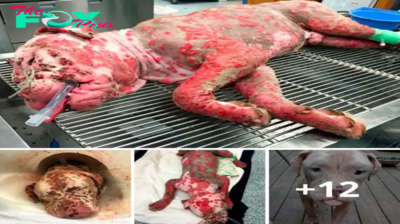Pet
Lamz.Mangoworm Miseries: Unraveling the Troubling Tale, Tactics for Treatment, and Preventive Measures for Pup Protection
In the warm climates of certain regions, a sinister menace lurks, often unseen but deeply felt by man’s best friend: mangoworms. These parasitic pests, though small in size, can wreak havoc on the Health and well-being of dogs, causing discomfort, pain, and in severe cases, even death. Understanding the threat posed by mangoworms is crucial for dog owners everywhere.

Mangoworms are the larval stage of a type of fly known as the Cordylobia anthropophaga, commonly found in sub-Saharan Africa. However, they can also be found in other tropical and subtropical regions around the world. These tiny larvae, barely visible to the naked eye, typically infest the skin of maMMAls, including dogs, where they burrow and grow, causing a range of Health issues.
The lifecycle of a mangoworm begins when a female fly deposits her eggs onto the skin of a host animal, often attracted by sweat or the scent of bodily fluids. Once hatched, the larvae burrow into the skin, creating painful lesions and tunnels as they feed and grow. Left untreated, a single infestation can lead to severe skin infections, abscesses, and systemic illness in the affected dog.

Symptoms of mangoworm infestation in dogs may vary depending on the severity of the case and the dog’s immune response. Common signs include intense itching, hair loss, iNFLamed skin, and the presence of small, raised nodules or lumps, where the larvae are located beneath the surface. In advanced stages, dogs may exhibit signs of pain, lethargy, and reluctance to move or eat.
Treating mangoworm infestations requires a multi-faceted approach aimed at removing the larvae, treating the affected skin, and preventing secondary infections. In mild cases, manual removal of the worms using forceps or tweezers may suffice, followed by thorough cleaning and disinfection of the affected area. However, more severe infestations may necessitate the use of specialized medications, such as anti-parasitic drugs or antibiotics, prescribed by a veterinarian.

Preventing mangoworm infestations in dogs involves several key strategies, including regular grooming and inspection of the dog’s skin, especially after outdoor activities in areas where the parasites are prevalent. Additionally, keeping the dog’s living environment clean and free of organic debris can help reduce the risk of infestation. In regions where mangoworms are endemic, using insect repellents and protective clothing for dogs may also be advisable.
While mangoworm infestations in dogs can be distressing and challenging to manage, early detection and prompt treatment are essential for ensuring the best possible outcome. By remaining vigilant and proactive in protecting their canine companions, dog owners can help safeguard against the threat of mangoworms and ensure their Pets lead happy, Healthy lives free from parasitic pests.
-

 Pet2h ago
Pet2h agoson.A cat named Coco has caused a stir in the online community because she is so cute with 4 special ears and a ‘Mlem’ expression on her face.
-

 Pet2h ago
Pet2h agoson.The joy of old dog Lola: An emotional return when a military mother unexpectedly returns after many years of serving her country.
-

 Pet4h ago
Pet4h agoAbandoned Dog Cry Nonstop For Days, Looking At Each Car & Hoping Owner Would Come Back To Pick Her
-

 Pet6h ago
Pet6h ago“Stinger’s Triumph: The Inspiring Journey of a Deaf Pit Bull Battling Life-Threatening Blisters” -zedd
-

 Pet9h ago
Pet9h agoQT “A Canine’s Profound Appreciation: Experiencing Overflowing Gratitude by the Warmth of its Owner”
-

 Pet9h ago
Pet9h agoQT A Homey Haven: The Beagle Sofa Sanctuary
-

 Pet12h ago
Pet12h agoLamz.Stinger’s Odyssey: The Deaf Pit Bull’s Courageous Fight Against Life-Threatening Blisters
-

 Pet14h ago
Pet14h ago1S.A tiny kitten with large eyes, smaller than usual, finds refuge with a family that rescued it, and eventually blossoms into a beautiful cat.

















